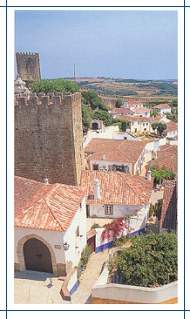 |
© JAMP -
Ediçőes Turísticas |
|
|
To the visitor this charming
small-fortified town is suggestive of a medieval film set. It has been carefully preserved
and its inhabitants take careful pride in maintaining the architectural image of days gone
by. Impressive 18th Century blue tiles line within the southern gate that is known
appropriately as Porta da Vila and acts as the entrance into the town. Besides its
historic importance, the Igreja de Santa Maria is also the resting-place of the Count of
Dijon, D. Joăo de Noronha and his wife D. Isabel de Sousa whose tombs
were finely sculpted c. 1525 by Nicolau Chanterenne. On the opposite side of the square to
the church is a Manueline pillory adorned with a fishing net that symbolises the efforts
of the local fishermen who unfortunately failed to save the Queen's son from drowning. The
ancient town walls have been restored over the centuries and the castle itself has been
carefully turned into a charming Pousada. The town was also the permanent home of the
painter of the 17th Century. Josefa de Óbidos as she is commonly known was born in
Seville but her Portuguese father who was also a painter brought her back to Óbidos at
the age of six where she was to remain for the rest of life. Not withstanding the high
quality of her work the fact that she as a woman of that time was given public commissions
and accepted in society makes Josefa de Óbidos an exceptional artist in history. The
small museum alongside the main church has a few of her many remaining works. Reasonably
close to the town is the Santuário do Senhor da Pedra that was built as from 1740. This
architectural hexagonal shaped church stands alone on the landscape and is still sadly
unfinished to this day.
|
|
